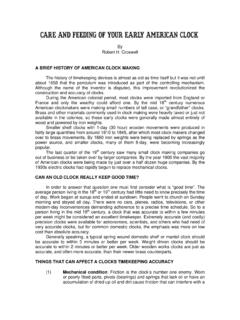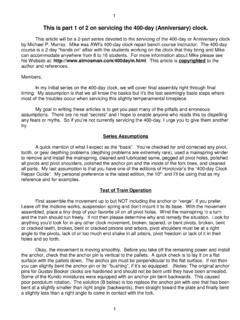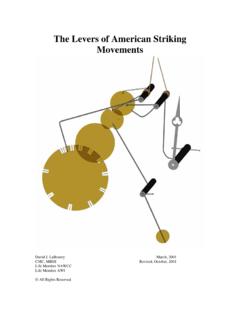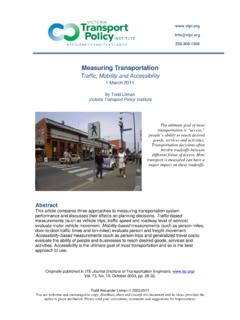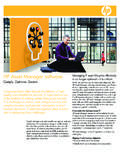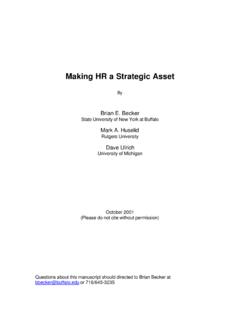Transcription of THE ART OF MAKING WATCH MAINSPRINGS, …
1 THE ART OF MAKING WATCH mainsprings , repeater SPRINGSAND balance SPRINGSByMr W. BLAKEYH ydraulic Engineer REY1780 Copyright 2014 Richard Watkins, Tasmania, from William Blakey L Art de Faire les Ressorts de Montres, 1780, Amsterdam: Marc-Michel Rey: :/12148/bpt6k61161354iiiContentsTranslat or s Notes ..ivBiography of William Blakey ..ivDating the Technology ..vThe Translation ..viBibliography ..viProspectus ..ixExtract From the Records of the Royal Academy of Sciences ..xiForeword ..xviiThe Art of MAKING WATCH mainsprings ..1 The Way to Make repeater Springs ..27 The Way to Make balance Springs..29ivTranslator s NotesBiography of William BlakeyWilliam Blakey was the son of an English watchmaker of the same name.
2 Blakey senior was born about 1688. He was apprenticed as a watchmaker in 1701 and died in 1748 aged 60. In 1718 he went to France where he was in charge of a steelworks in Nor-mandy which provided springs and pinion wire for the watchmaking factory in Versailles, set up by John Law and run by Henry Sully. He was a described as a horloger en ressorts, a spring senior and Sully were involved in the creation of the Paris Society of Arts circa 1718, which originated from the academic project of a Description des Arts et M senior had at least two children, but the information on them is contradictory. Nicholas Blakey is said to have been born in Ireland, probably shortly after 1711. He was an artist and book illustrator.
3 William Blakey junior was apparently born in London in 1711 and went to France with his parents. It is clear that he followed his father into the steel MAKING business and they probably worked together. Then, before 1744, he established (or took over) a mill for draw-ing pinion wire. This was regarded as an invention by the Paris Academy of Science, and in 1744 Blakey received exclusive rights for his process, promising to sell at one-third less than English the same time, in 1742, he entered the Parisian Guild of Surgeons as a chirurgiens bandagistes, a truss maker, producing elastic steel trusses with steel springs. In 1750 he joined the guild of watchmakers. However, there is no evidence that he had trained in watchmaking, and acceptance into the guild was probably because he was, like his father, a horloger en ressorts.
4 However, his article On Horlogery indicates some knowl-edge of watchmaking. In 1759 Blakey was involved in creating an iron rolling mill and machines for MAKING files at Essonnes near Paris. This establishment also made trusses. And in 1761 he was granted a privilege to manufacture 1765, Blakely was awarded an exclusive contract with Benjamin Huntsman to use Huntsman s steel in 1777, Blakey moved to Li ge, presumably to retire. On 9 January 1778 he wrote a letter to Benjamin Franklin that contains the following strange remarks:I shall soon have my Art of WATCH and Clock spring MAKING in Print. I send you the preface to give you an idea of it. I shall send it you when finishd as a thing of some use to those brave defender of Liberty, who have saved England from the Yoke a Tyrant was aworking under the name of his servants as I have said in my letter on the times.
5 The date of William Blakey s death is not known. vDating the TechnologyAlthough L Art de Faire les Ressorts de Montres was published in 1780, it is clear that most of it is based on methods used much report of the Acad mie royale des sciences indicates that only Sections 1 to 69 (describ-ing WATCH mainspring MAKING ) were supplied to the Academy in 1772, and it is possible that the remaining sections (70 to 97 on repeater springs and balance springs) were writ-ten after that date. However, in the Prospectus Blakey states that he had the 12 plates engraved about 1772, suggesting he had at least planned the text for the later sections. And although clock springs are mentioned, it seems Blakey never wrote about most important dating evidence comes from the book.
6 In it, Blakey repeatedly refers to the inventions and improvements made by his father, who died in 1748, and what ap-pears to be his only invention in this field (the large leads tool, page 16) was designed when he was young and his father was alive, about 1730 or a little this we can add that in Section 14 (page 4) Blakey states that Forty years ago we found tools that give such perfect equality, that it could be done without drawn wire . That is, about 1740. And in Section 26 (page 10) he states that he had seen about 50 years ago, springs hardened by folding them in small circles about three inches in diameter ; a method which had been superseded by his father.
7 Although not certain, this remark prob-ably refers to a consequence, we can be confident that the first part of the book, on WATCH main-springs, is based on methods circa 1740 or earlier. The second and third parts (on repeater and balance springs) use the same type of meth-ods and probably date from the same period. The only new tool, the English method of MAKING balance springs with rolled wire blades (Section 89, page 32) was used, accord-ing to Blakey, in the 17th century. If so, none of the book describes modern methods, and we must assume that spring makers used the same techniques in 1772 - 1780 as they had used in the 1740s and probably is a little strange. Blakey describes MAKING mainsprings by hand hammering an-nealed steel rods to produce flat blades.
8 But he notes that the English method for MAKING balance springs, by rolling rods in a mill, was superior. So why was this method not trans-ferred to MAKING mainsprings ? After all, Blakey had made hot iron rolling mills to produce plates, and one would think that it would be relatively easy to transfer this experience and his knowledge of the English method of rolling balance spring wire to the MAKING of mainsprings . Blakey answers this question in Section 14 (page 4):Forty years ago we found tools that gave such perfect equality, that it could be done without drawn wire. But routine prevented workers from departing from the method of preparing their steel as round wires and then forging vague, it appears that the English method was well 1763 Ferdinand Berthoud described how to make clock mainsprings and, allowing for the difference in size, his methods are, in all important respects, identical as those de-scribed by Blakey: A shaped (rather than round) rod is annealed, hammered to thickness and sheared to the right width.
9 Then it is placed on the wheel in Plate 4 Figure 4 (page 10) and hardened in oil. The blade is then tempered grey, hammered and filed again, viand blued. It is then made into a spiral on a large mainspring winder with cards between the inner turns. Finally, it rewound on the mainspring winder without the cards. Berthoud does not mention William TranslationAlthough translating this book was straightforward, the strange and inconsistent punc-tuation caused some problems. Also, a few unusual words required a bit of inspiration to understand. To help the reader I have included a few footnotes where I think an explana-tion is translation is in no sense literal. Where the French is clumsy when expressed in Eng-lish, I have preferred to stray from the original and, hopefully, produced a clearer the illustrations were on 12 plates at the end of the book, To make this book easier to read, I have placed the illustrations in the text at the appropriate places.
10 And, because some illustrations are referenced in several places, I have duplicated them where necessary. The labels have been replaced, correcting a few minor of Sciences, 1772, Proc s-verbaux Acad mie royale des sciences, volume 91, 1778. (Available from :/12148 +Acad%C3%A9mie+royale+des+sciences+ )Baillie, , 1988, Watchmakers & Clockmakers of the World, England: , Ferdinand, 1763 and 1786, Essai sur l Horlogerie, Paris: Merigot, Didot, , Ferdinand and Auch, Jacob, 2007, How to Make a Verge WATCH , Richard Watkins: Tasmania, , Nicholas, , William, 1758, Instruction pour Pr venir les Descentes ou Hernies, Paris: G. De-sprezBlakey, William, 1769, Letter to Mr Ferguson on Blakey s Fire Engine and Descrip-tion of Mr Blakey s Patent Fire Engine , Gentleman s Magazine, Volume XXXIX, pages 392-394, 1 plate, London: Sylvanius Urban.
